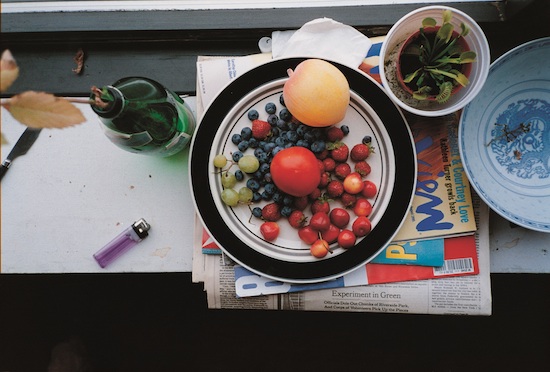Manny Farber, Domestic Movies, 1985, oil on board, 96 × 96 in. (243.84 × 243.84 cm), ResMed collection
Sprawled across and throughout the many of Manny Farber’s brightly coloured, still life paintings are various foods, utensils, papers with writing scrawled over them – both legible and illegible – matchsticks, toy figurines, notebooks, photographs, flowers, the list goes on. Is the quotidian, one begs to ask, that of objects? Is the every day, I mean, that which shall be seized by the object? The human presence of these objects and these still life canvases, to the dismay of object-oriented ontology devotees, are non-negotiable. The life from the still life is precisely from the invisible human presence aggravated, ironically, by the absence.
Known for his essay, ‘White Elephant Art vs. Termite Art’, championing a slower art dedicated to the everyday over the grandeur of “White Elephant Art”, American artist Manny Farber was equally known for his work as a film critic, applying the same sensibilities to various forms of art. More explicitly in the essay, Farber referred to White Elephants as films receiving critical acclaim and awards during the 1950s whereas termite art was coined to describe the more interesting, less awarded films of the time. One Day at a Time at the Museum of Contemporary Art, Los Angeles (MOCA), takes Farber’s infamous termite ethos as its guiding process in this group exhibition comprised of thirty artists including, but not limited to, Wolfgang Tillmans, Jordan Casteel, and Vija Celmins.
Farber’s circular painting Rohmer’s Knee (1982), for instance, pays homage to French filmmaker Eric Rohmer’s 1970 film Claire’s Knee. To reference Rohmer is unsurprising, given that the French auteur’s works are known for their slowness that leverage dialogue over action, taking heed to the mundane, yet in no way elevating the day-to-day activities and conversations. Split model train tracks circumnavigate the circular train track formation in the centre of the work which enclose objects such as a paper with writing that states “What’s wrong with off the top of the head?” The phrase, giving hold to the centre of the painting, becomes redundant with the seemingly random objects and scenes painted throughout Rohmer’s Knee – a slice of cheese balancing a ruler with miniature figures sitting on it, creating a makeshift seesaw, open books, and various other precious detritus of the every day. In the top left of the circular canvas, I noticed the pivotal scene of the film’s title, where Claire’s knee is noticed by the film’s protagonist as she climbs a ladder. A figurine on a toy boat, again not unlike the protagonist himself on his boat in various scenes of the film, stares down at the painted scene of the exposed knee. A viewpoint from above, yet one can see the workings within – particularly the artist (or figurine) working within and in the midst – the figurine and the scene indicate to the painting’s working at a miniature and meta- scale.
Temporality is another key issue taken up in Farber’s works and remarked upon in the show. Slowness is lauded as is a convergence of various temporalities, favoured over a linear viewpoint of time. One can track this acutely in a gestural manner, particularly in Story of the Eye (1985). Referencing French writer Georges Bataille’s transgressive 1928 erotic novella, Farber gestures to the psychological and psychoanalytical issues of erotics, death, and violence, highlighting the personal. A nest of eggs, although unpeeled, cheekily allude to the other “eye” in the novella as many various objects stand in as such. Divided into panels of blue, red, black, white, and green, respectively, plates of food occupy more than one panel and flowers lean over and spill into to the neighbouring panel – an occupying simultaneity rejecting the exclusive and progressing nature of the panels. The canvas begins with a bouquet of flowers and ends with a bouquet of flowers in their own respective panels reflecting a cyclical sense of time side-by-side with simultaneity. Objects repeat in various forms. Despite the variance of these objects, looking at the painting, they all seem to be vessels, embodying the same, sensuality or eye, that is, in different forms. On a general scale, one is aware of the omnipresent eye, yet drawn back into the personal particulars, becoming aware of one’s own observing at Story of the Eye.

Wolfgang Tillmans, summer still life, 1995, courtesy of the artist and Regen Projects, Los Angeles
Vija Celmins’s works, on the other hand, elongate the scale of the everyday into the cosmos. Having just seen her retrospective at the San Francisco Museum of Modern Art, I was thrilled to run into another Celmins painting of the night sky. Unlike Farber’s work, Celmins’s still life denies an anthropomorphic-centred lens through which to look at – or, at the very least, denies it on such a direct level. While Farber encouraged a painting in the midst of the every day, being within it, rather than seeing it from a distance, Celmins’s work creates a more universal focus with her painting. Star Field II (Moving Out) (1982) depicts the night sky flooded with stars of various sizes. Compared to the various Farber paintings, one takes Celmins’s title of “Moving Out” quite literally in translating the stillness of Farber’s tabletops to the natural, physical environment and its sublime. The day to day, Celmins’s seem to say, in conversation with Farber, by scaling down the vast cosmos onto small canvases, have very much to do with both our consciousness and experience.
Walking throughout One Day at a Time and seeing the various artists that have engaged with the termite ethos, dominated by the amount of Farber works, I can see a larger, all encompassing Farber canvas drawing together each of the works. Not in a homogenising sense, that is to say, but rather, that these works are not so much in conversation with Farber’s works as they are intrinsically a part of it.
Wolfgang Tillmans’s Summer still life (1995) which may, arguably, be a photographic representation of Farber’s table top, object strewn paintings, with its plate of fruit on stacks of magazines and newspapers and various bowls and plants in bottles and lighter at the end of the windowsill, imbues into it narratives of the everyday. An absent-minded smoker’s careless placement of the lighter after flaming her cigarette. The thoughts she had while leaning on the windowsill, breathing outside her cigarette smoke. One wonders why she, why Tillmans, perhaps, left the bowl of fruit there.
One day at a time, one canvas, one work at a time, one thought at a time – they all advocate for a slowness and slower appreciation of time rather than sequestering off the lighter from the bowl of fruit or the pile of publications on which the bowl sits. They exist at the same and exist at multiple temporalities. In a world where rapidity is rewarded and feedback is looped, One Day at a Time provides a much needed temporal jerk and enables us to practice Farber’s famed termite spirit.
One Day at a Time: Manny Farber and Termite Art is at the Museum of Contemporary Art, Los Angeles, until 11 March


